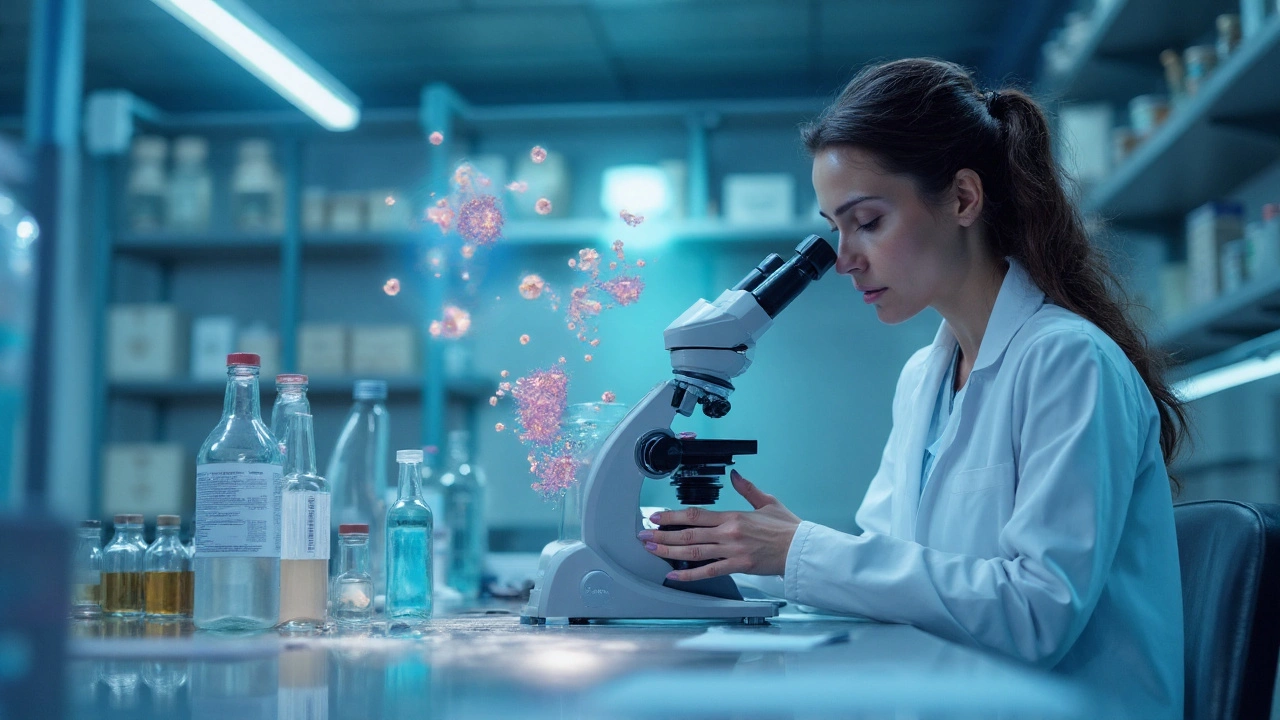 Sep, 25 2025
Sep, 25 2025
Alcohol consumption is a behavior involving the intake of ethanol-containing beverages that varies widely across populations. Breast cancer is a malignant growth originating from breast tissue cells and represents the most common cancer among women worldwide. In the past decade, dozens of epidemiological studies have examined whether a dose‑response relationship exists between the two. This article breaks down the biology, the numbers, and the everyday choices that shape risk.
Why Hormones Matter: The Role of Estrogen
One of the key pathways linking alcohol to breast cancer is through estrogen. Alcohol can raise circulating estrogen levels by up to 20% in women who drink moderately, according to the World Health Organization. Higher estrogen stimulates breast cell proliferation, increasing the chance of DNA errors that can become cancerous. This hormonal boost is especially significant for post‑menopausal women, whose primary estrogen source is peripheral conversion of androgens - a process alcohol accelerates.
What the Numbers Say: Relative Risk and Dose‑Response
Scientists measure the impact of alcohol on breast cancer using relative risk (RR). An RR of 1.0 means no effect; above 1.0 indicates higher risk. A 2018 meta‑analysis by the International Agency for Research on Cancer found:
- Women who consume 1-2 drinks per week have an RR of about 1.05 (5% increase).
- Those drinking 3-7 drinks per week see an RR near 1.15 (15% increase).
- More than 7 drinks per week pushes the RR to 1.30 or higher, a 30% rise.
The pattern is linear: each additional standard drink per day raises risk by roughly 7%. This dose‑response relationship holds after adjusting for smoking, diet, and body‑mass index, suggesting a direct effect of alcohol itself.
Genetics and Lifestyle: Interacting Risk Factors
Alcohol isn’t the only player. Women carrying BRCA1/BRCA2 mutations already have a high baseline risk. When combined with regular drinking, the excess risk compounds. A UK cohort study noted that BRCA‑positive women who drank more than 3 drinks per week had a 2‑fold higher incidence than non‑drinkers with the same genetic profile.
Other lifestyle factors-such as physical inactivity, high‑fat diets, and hormone‑replacement therapy-can amplify alcohol‑related risk. Conversely, regular exercise and a diet rich in fruits and vegetables appear to blunt the hormonal surge caused by alcohol, offering a modest protective effect.
Understanding a "Standard Drink"
Public health messages often use the term "standard drink" to standardise intake. In the UK, a standard drink contains roughly 8 grams of pure ethanol, equivalent to:
- One small glass (125ml) of wine at 12% ABV.
- Half a pint (284ml) of average‑strength beer (4% ABV).
- One single measure (25ml) of spirits at 40% ABV.
Counting drinks, rather than glasses, helps women track actual alcohol exposure and align with risk thresholds identified in research.

Comparing Risk Across Consumption Levels
| Alcohol Intake | Average Drinks per Week | Relative Risk (RR) | Estimated Additional Cases per 10,000 Women |
|---|---|---|---|
| None | 0 | 1.00 | 0 |
| Low | ≤1 | 1.05 | 5 |
| Moderate | 2-7 | 1.15 | 15 |
| High | >7 | 1.30+ | 30+ |
These figures translate population‑level data into a tangible sense of how even modest drinking can add cases over a decade.
Preventive Guidelines and Practical Tips
Many health agencies now incorporate alcohol limits into preventive guidelines. The UK’s Chief Medical Officer recommends women keep weekly alcohol units below 14 (≈7 standard drinks). For breast‑cancer‑focused prevention, the WHO suggests aiming for zero‑alcohol days each week and using non‑alcoholic alternatives at social events.
Practical steps:
- Track each drink in a mobile app; note size and type to convert to standard units.
- Replace one alcoholic beverage with sparkling water or a herbal mocktail on weekdays.
- Schedule a regular mammography screening appointment; early detection offsets some risk.
- Combine alcohol reduction with exercise-150 minutes of moderate activity per week cuts overall cancer risk by roughly 10%.
- Discuss personal risk with a healthcare provider, especially if you have a family history or known genetic mutations.
Addressing Common Misconceptions
Myth: “A glass of red wine is heart‑healthy, so it must be safe for breasts.” Reality: While moderate wine may benefit cardiovascular health, its ethanol component still elevates estrogen and therefore breast‑cancer risk. The net effect depends on individual baseline risk.
Myth: “Only heavy drinkers are at risk.” Reality: The dose‑response data show that even low‑level consumption carries a measurable increase, especially when combined with other risk factors.
Myth: “Alcohol‑free beer is risk‑free.” Reality: Some “alcohol‑free” products contain up to 0.5% ABV, which can still contribute to cumulative exposure if consumed in large quantities.
Putting It All Together: A Personalized Risk View
Think of risk as a layered cake. Genetics form the base, lifestyle factors like diet and activity add the middle layers, and alcohol is an extra topping that can tip the balance. By trimming the alcohol topping, you lower the overall height, making the cake less likely to cause a problem.
For a 45‑year‑old woman with a moderate family history, cutting from 5 drinks a week to 1-2 can reduce her projected 10‑year risk from 12% to about 9%, according to the latest risk‑prediction models used in UK breast‑cancer clinics.

Frequently Asked Questions
How many drinks per week are considered safe for breast‑cancer prevention?
Most experts advise no more than 7 standard drinks per week, with several alcohol‑free days. Even lower intake further reduces risk, especially for women with additional risk factors.
Does the type of alcohol (wine, beer, spirits) matter?
The carcinogenic effect stems from ethanol itself, so the risk is similar across beverage types when measured in standard drinks. Some studies suggest a slightly higher risk with spirits due to higher ethanol concentration per serving.
Can I offset alcohol risk by taking vitamins or supplements?
No supplement has been proven to neutralise ethanol’s hormonal impact. A balanced diet rich in antioxidants may help overall health, but it does not eliminate the increased breast‑cancer risk from alcohol.
How does alcohol interact with hormone‑replacement therapy (HRT)?
Both alcohol and HRT raise circulating estrogen. When combined, studies show a synergistic effect, roughly doubling the relative risk compared to either factor alone.
Is there a safe level of alcohol for women with BRCA mutations?
Current guidance recommends minimizing alcohol as much as possible. Even low‑level consumption can add a measurable risk to an already elevated baseline for BRCA‑positive women.
Does occasional binge drinking have a bigger impact than regular low‑level drinking?
Binge episodes cause spikes in estrogen and inflammatory markers, potentially creating more DNA damage than the same total amount spread evenly. Reducing binge frequency is therefore advisable.
What role does mammography play in managing alcohol‑related risk?
Regular mammography catches tumors early, improving prognosis regardless of risk level. Women who drink alcohol should adhere strictly to screening intervals-every 2-3 years until age 50, then annually.
Julia Grace
September 25, 2025 AT 03:20Alright, so the link between booze and breast cancer is kinda like a sneaky side‑kick – you might not see it at first but over time it adds up. First off, alcohol boosts estrogen levels which can nudge breast cells to grow faster, raising the odds of mutations. Even a couple of drinks a week can lift your risk by about five percent, which sounds tiny but adds up across a whole population. The dose‑response curve is pretty straight – each extra drink per day nudges the risk up roughly seven percent. If you’re drinking three to seven drinks weekly, you’re looking at a fifteen percent bump, and more than seven pushes it past thirty percent. For women with BRCA1 or BRCA2 mutations the effect is even sharper – the combo can double the incidence compared to non‑drinkers with the same genes. Lifestyle factors like a sedentary routine or a high‑fat diet can amplify that estrogen surge, while regular exercise and a veggie‑rich diet can blunt it a bit. Tracking drinks in standard units rather than glasses helps keep the math honest, because a ‘glass’ can mean different things across drinks. The UK defines a standard drink at about eight grams of pure ethanol – that’s roughly a small wine glass or half a pint of average beer. Health agencies now suggest keeping weekly intake under fourteen units (about seven standard drinks) for women, and many experts push for zero‑alcohol days each week. If you’re a social drinker, swapping one evening glass for sparkling water can shave off a decent chunk of risk. Pairing reduced alcohol with the recommended 150 minutes of moderate exercise weekly can trim overall cancer risk by around ten percent. Don’t forget regular mammograms – early detection still matters no matter how you slice the risk. Ultimately, think of risk like a layered cake: genetics are the base, lifestyle the frosting, and alcohol the extra topping that can tip the balance. Cutting back on that topping, even modestly, makes the whole cake less likely to cause trouble.
Sadie Bell
September 29, 2025 AT 04:34Just a quick reminder that you don’t have to go cold turkey – cutting down a drink here or there adds up big time.
Noah Bentley
October 3, 2025 AT 05:47Wow, another article telling us booze is bad for you – shocking, right? It’s not rocket science that ethanol is a toxin, but apparently we need a dissertation for it. The hormone spiel is just a fancy way of saying “drink more, get more estrogen”. And sure, the numbers show a 7% risk boost per drink, but who’s counting when you’re at the bar? If you think a single glass of wine won’t hurt, remember it’s still ethanol. The meta‑analysis you cited is just a collection of studies that already knew this, so it’s not groundbreaking.
Kathryn Jabek
October 7, 2025 AT 07:00While the preceding comment treats the data with a degree of nonchalance, it is incumbent upon us to recognize the profound implications of cumulative ethanol exposure on oncogenic pathways. The elevation of circulating estradiol, as delineated by the WHO, constitutes a mechanistic conduit for augmented mitotic activity within mammary epithelium. Moreover, the statistical gradient observed across consumption brackets underscores a linear, albeit modest, augmentation of relative risk. Such findings warrant a judicious appraisal of personal consumption habits, particularly among BRCA mutation carriers, whose baseline susceptibility is already considerable. In sum, the discourse should eschew flippancy and adopt a more rigorous, evidence‑based posture.
Ogah John
October 11, 2025 AT 08:14Think about it – we’re all trying to balance life, and a glass of wine can feel like a tiny ritual. If you replace a few of those with a herbal mocktail, you keep the ritual without the estrogen surge. It’s not about demonizing fun, just about smarter choices.
Kelvin Murigi
October 15, 2025 AT 09:27Great summary! For anyone looking to track their intake, I recommend apps like DrinkTracker – they let you log each drink with the type and size, converting it to standard units automatically. It makes it easier to stay under the recommended limit.
ahmad matt
October 19, 2025 AT 10:40Seriously, people think “I only have a beer on weekends” is harmless. That binge spikes estrogen and inflammatory markers more than sipping a drink daily. And those “alcohol‑free” beers still have trace ethanol – don’t be fooled.
kristine ayroso
October 23, 2025 AT 11:54From a cultural standpoint, many social events revolve around drinks, but you can still enjoy the vibe with sparkling water infused with fresh fruit. It’s a win‑win for health and social bonding.
Ben Small
October 27, 2025 AT 12:07Cut back, feel better.
Dylan Hilton
October 31, 2025 AT 13:20Just a heads‑up: using a consistent logging method helps you see patterns you might miss otherwise. It’s a simple habit that can make a big difference in staying within safe limits.
Christian Andrabado
November 4, 2025 AT 14:34Honestly, the endless cautionary tales about alcohol just drain the fun out of life. We all know it’s a toxin, but moderation is key, not total abstinence.
Chidi Anslem
November 8, 2025 AT 15:47From a philosophical angle, the notion of “risk” is a construct that aids public health policy, yet individuals must weigh personal values against statistical probabilities. While the data are sound, the decision to limit alcohol involves cultural, social, and personal dimensions that extend beyond pure epidemiology.
Holly Hayes
November 12, 2025 AT 17:00People keep drinking like there’s no consequences, but the numbers don’t lie – even a few drinks a week nudges the odds up. Stop ignoring the science.
Penn Shade
November 16, 2025 AT 18:14Let’s be clear: the relative risk figures are based on large cohort studies with robust methodology. If you’re skeptical about the 7% per drink figure, look up the IARC 2018 meta‑analysis – it’s peer‑reviewed and widely cited.
Jennifer Banash
November 20, 2025 AT 19:27Oh dear, another moral lecture about alcohol. As if we needed a lecture to tell us not to enjoy a glass of wine. The drama of it all is exhausting.
Claus Rossler
November 24, 2025 AT 20:40One could argue that focusing heavily on incremental risk per drink distracts from larger societal issues like access to healthcare and education. Yet, I concede that personal responsibility in consumption does play a non‑trivial role.
Kristie Barnes
November 28, 2025 AT 21:54If you’re looking for a low‑key way to cut down, try setting a “no‑drink” day each week. It’s a simple habit that can reduce cumulative exposure without feeling restrictive.
Zen Avendaño
December 2, 2025 AT 23:07Totally agree – setting a designated sober day helps keep the weekly total in check, and it’s easier than trying to count every single sip. Plus, you’ll notice other benefits like better sleep.
Michelle Guatato
December 7, 2025 AT 00:20What they don’t tell you is that the alcohol industry funds a lot of the “moderate drinking” research – classic conflict of interest. Trust the independent data instead.
Gabrielle Vézina
December 11, 2025 AT 01:34Seriously, the whole “wine is healthy” narrative is a PR spin. Ethanol is ethanol, regardless of the fancy label on the bottle. Cut back, it’s that simple.